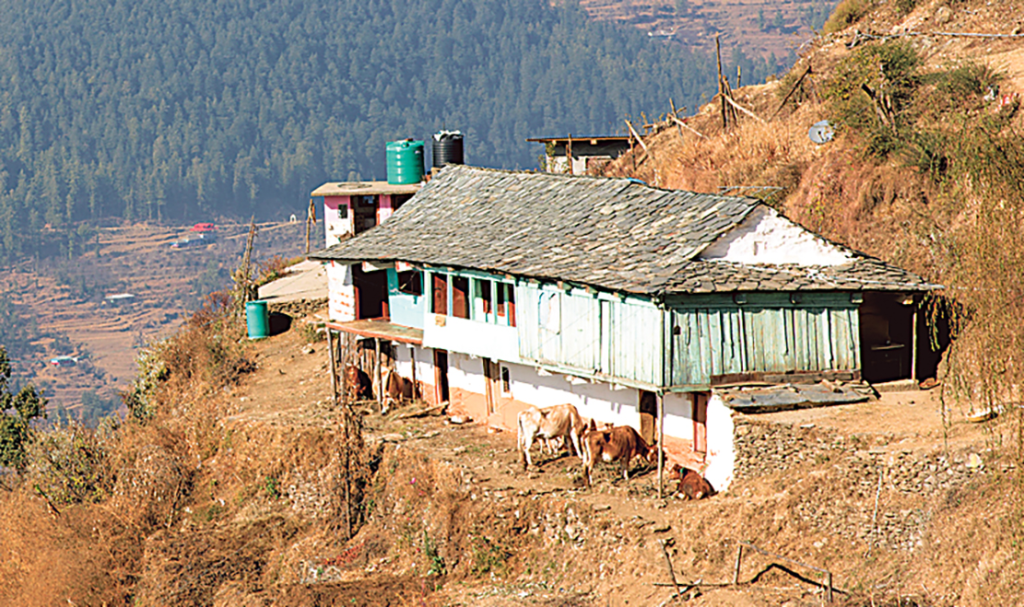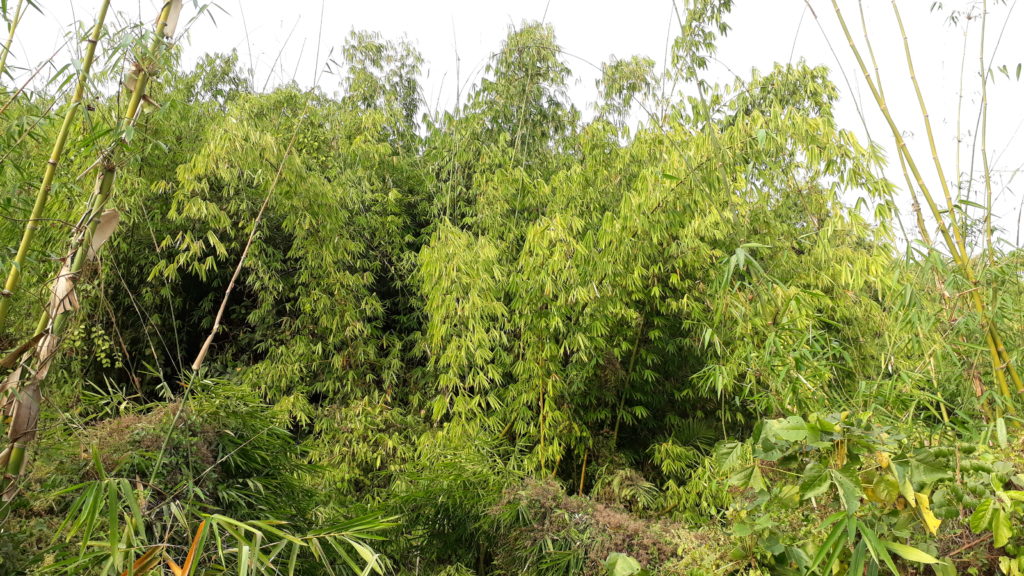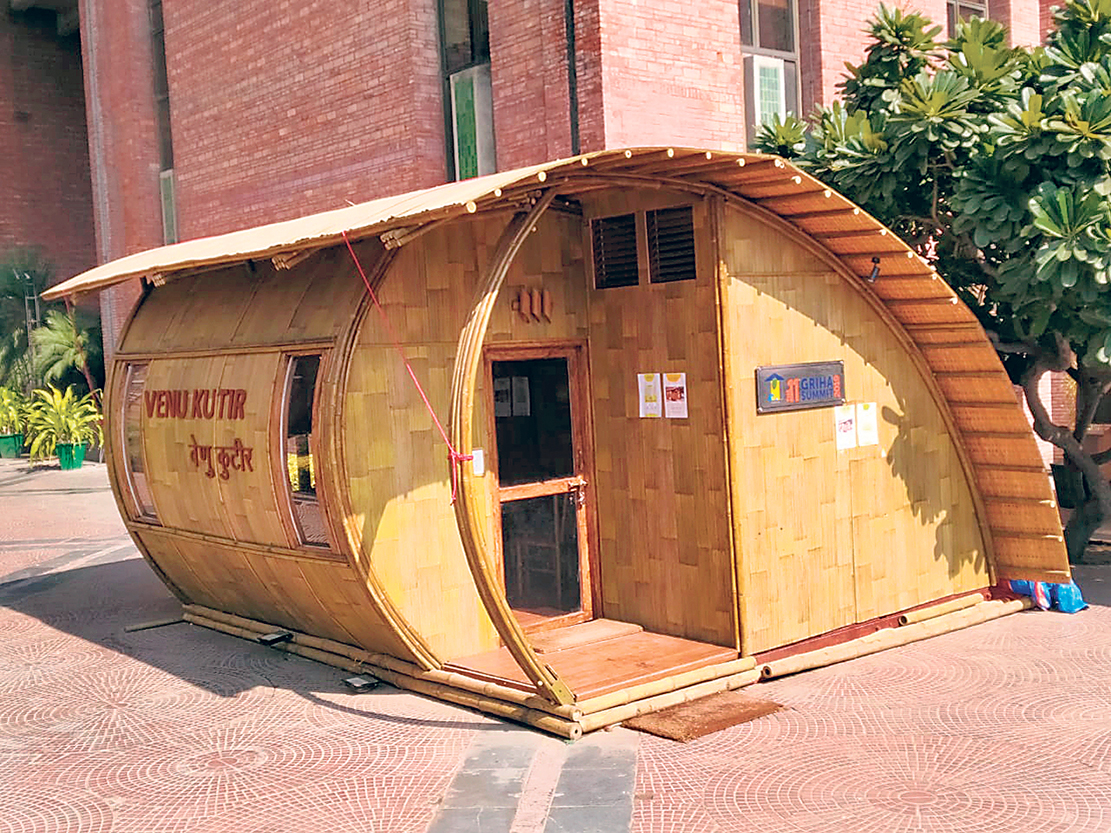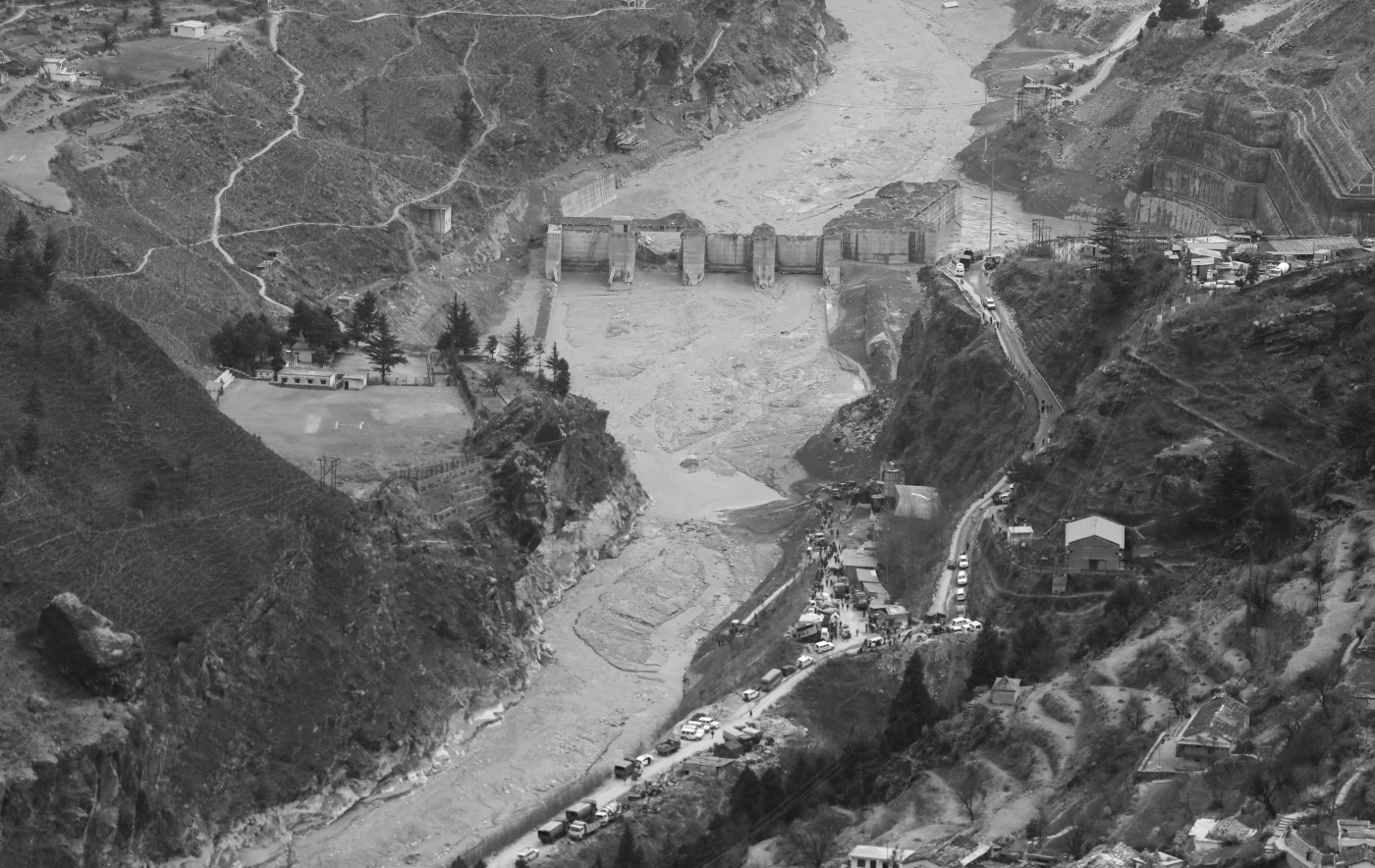Bamboo is one of the most sustainable and environment-friendly materials to build a structure with a negative carbon impact
A tony bamboo house installed near the open lawns at the India Habitat Centre in Delhi has been a centre of attraction for visitors since mid-December. Installed on the sidelines of the annual GRIHA Summit, this is a 240-sq feet bamboo cottage for a ‘cozy and comfortable living space’.
The cottage continues to be at the IHC long after the Summit in December 2019 prompting visitors to take photos of it or click selfies in front of it. A poster displays information about why it is there, and many people make effort to read it.
The Energy and Resources Institute (TERI), which had installed the aptly named ‘Venu Kutir’ (bamboo in Sanskrit is Venu) said, the idea to put that up was to highlight the fact that the use of steel, concrete, aluminum and glass in construction ends up negatively impacting the atmosphere through the release of greenhouse gases (GHGs) during its production as well as construction.
In contrast, studies have established that bamboo emits oxygen during its production and selected species of Indian bamboo sequesters up to 200 MT of carbon dioxide per hectare per year. Hence, bamboo is one of the most sustainable and environmentally friendly materials to build a structure with a negative carbon impact, and it can become the go-to material for sustainability. Indeed, bamboo can be used to build durable and contemporary structures that appeals to the aesthetic senses of the millennials and old generation alike.
Almost all states of the North-East India have a variety of bamboo houses, with unique designs for each of the ethnic groups, but in rest of India, the concept is not yet widely accepted. In recent years, an increasing number of resorts are taking up the concept of bamboo houses/cottages. But there is yet no widespread use of bamboo in construction business overall.
Traditionally, across India, timber and bamboo have been most favoured building materials. But thanks to skewed policies such as bamboo put under ‘tree’ category and blindly aping of the western designs, the use of cement/RCC in buildings has gone up exponentially. Then, a major policy change happened in December 2017 when the Centre pulled out bamboo from the ‘tree’ category back to it being a ‘grass’. This eased the restrictions on its commercial growing and cutting. Things are changing but only slowly and it may be another five years, when more and more people grow bamboo and the real impact will be seen on ground once the business eco-system involving bamboo is stabilized.
Back to bamboo and timber housing
Once, each of the regions had a unique architecture to showcase, entirely based on locally available resources. A Himachali house will have slate stone roof and timber below it for support, Konkan coastal area house will necessarily have a sloping red tiled (kavelu) roof, a typical Madhya Pradesh rural area house will have a mud-floor/mud-wall house polished with cow-dung paste, or a traditional house in Arunachal Pradesh have bamboo as a major player with wooden logs for stilts.

Timber and slates are used in conventional Himachal houses (Pic from The Tribune)
Travel to any city across India, all of them have started to look the same. Hideous RCC buildings, similar high-rises with no or very less aesthetics, stone tiles adorning the floors and at times wall, and, in recent decades, glass façades. The virus is spreading to the rural areas too as living in a pucca makan (a cement concrete house) is aspirational. The latest government announcement of ensuring a pakka makan to all also points towards brick and cement mortar buildings.
Little that the policy makers and common people realise that most of the building materials that is used today has embodied energy, it causes environmental damage (loss of forests due to mining included), there is a transportation cost as it needs to be ferried from long distances. “Any of the materials we use – steel, cement, aluminum, anything leaves a trail of environmental destruction. How long can we continue inflicting environmental damage? There is soon going to be a crisis for whole of the building industry, especially in view of the impact due to looming climate change,” says Prof K T Ravindran, architect, town planner and former head of Delhi Urban Arts Commission (DUAC).
Ravindran himself has been extensively using timber in various forms in his projects. And no, he does not advocate cutting primary forest for timber. Instead, there is ample scope for using secondary timber. It grows rapidly and there are variety of options available. He also advocates use of bamboo that grows rampantly all over.
Bamboo is a highly underutilized produce. It regenerates itself and for commercial plantation too, it grows very fast. Bamboo can be a game changer if wisely deployed in building both – high end houses using chemical processed bamboos and low-cost affordable houses for housing for all. It will not just help bamboo growers multiply incomes but also prevent a hue damage to Mother Earth.
Delhi-headquartered non-profit Indian National Trust for Arts and Cultural Heritage (INTACH) has initiated a project documenting the vernacular building forms, local construction materials and techniques. As state wise inventory piles up, most common traditional materials surface as timber and bamboo.
But the problem is bamboo for houses is not yet used widespread. Except for north-eastern states, most applications include resorts, some fancy banquet halls, farmhouse or even some temporary exhibition area. “It is only now that the Indian construction companies are waking up to replacing many things with bamboo. There are bamboo boards, flooring, plyboards, furniture, you name it. Everything made of bamboo in the market for quite some time. But in absence of any incentives, production never really has scaled up. There needs to be a demand so that with volumes, prices can come down too,” observes Sandeep Theng of the Indian Federation of Green Energy (IFGE).
Skeptics question the use of timber and bamboo for high-rises saying bamboo or timber can be good only for single or double story-houses. How can it replace the booming high-rise building business? “People are highly unaware that bamboo’s tensile strength is far more than steel. It can very well be used in high-rise buildings,” Theng says.
Ravindran points out, “It has also something to do with quantum of buildings. High rises are unsustainable. They are expensive not only from monetary perspective but also from environmental perspective.”
But even if not high rises, to start with timber and bamboo buildings can be used to construct public utility buildings and government departments in cities. Bus stops, car sheds, bill payment kiosks, educational institutions, community buildings and many other buildings that are not high rises can easily be built using timber and bamboo.
“There should be a policy of incentivizing usage of bamboo in any type of building construction and by every ministry,” Theng suggests.
Bamboo and timber to fight climate change
The International Bamboo and Rattan Organisation (INBAR) lists benefits of bamboo for a wide range of livelihood applications as other forest resources become increasingly strained under climate change, as the imperative to mitigate climate change enforces less dependence on fossil fuels and endangered forest resources, and as research discovers new applications. Bamboo itself and many durable products made from bamboo can be potentially carbon-negative, because they act as locked-in carbon sinks in themselves.

With high unemployment rates, ongoing agrarian crisis, bamboo helps farmers adapt to adverse circumstances due to changing climate. Bamboo and its products can provide a year-round livelihood.
Published in ‘Scientific Reports’, a recent study by researchers at Cambridge University (UK) and University of Natural Resources and Life Sciences in Vienna (Austria) that examined bamboo’s thermal conductivity, showed that “the amount of heating and cooling required in buildings is fundamentally related to the properties of the material they are made from, particularly how much heat the materials used can conduct and store.”
Bamboo use can dramatically reduce emissions compared to traditional materials, helping to mitigate the human impact of climate change, Climate News Network reported quoting Darshil Shah of the Department of Architecture at Cambridge, who led the study. “People may worry about the fire safety of bamboo buildings. To address this properly we have to understand the thermal properties of the building material. Through our work we can see that heat travels along the structure-supporting thick cell wall fibres in bamboo, so if exposed to the heat of a fire the bamboo might soften more quickly in the direction of those fibres. This helps us work out how to reinforce the building appropriately.”
Earlier last week, a statement from the Potsdam Institute for Climate Impact Research advocated that buildings can become a global CO2 sink if made out of wood instead of cement and steel. A material revolution replacing cement and steel in urban construction by wood can have double benefits for climate stabilization, it says. First, it can avoid greenhouse gas emissions from cement and steel production. Second, it can turn buildings into a carbon sink as they store the CO2 taken up from the air by trees that are harvested and used as engineered timber. “However, while the required amount of timber harvest is available in theory, such an upscaling would clearly need most careful, sustainable forest management and governance,” the experts warned.
That is where the government policies in propagating commercial secondary timber and wide bamboo plantations can help play a major role.
(This story first appeared in ‘Spectrum’ of The Tribune on February 9, 2020 and can be read here)




